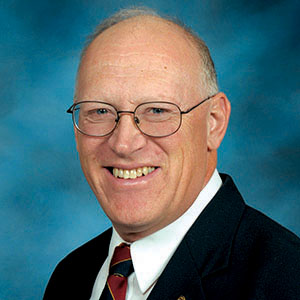Kansas Profile – Now That’s Rural: Miss Able, astromonkey
Oct. 25, 2023
By Ron Wilson, director of the Huck Boyd National Institute for Rural Development at Kansas State University
![]() Kansas has been home to several astronauts: Ron Evans, Joe Engle, and Steven Hawley, for example.
Kansas has been home to several astronauts: Ron Evans, Joe Engle, and Steven Hawley, for example.
But before these astronauts took flight, there was another native Kansan who ventured to outer space: Well, not an astronaut, but an astromonkey.
This is the true story of one of America’s first non-human space travelers and her connection to our state.
At right: Miss Able sign at Ralph Mitchell Zoo, Independence | Download this photo
The year was 1957. The Soviet Union surprised the world by launching the first artificial satellite, known as Sputnik. This caused major concerns that the United States was falling behind in the space race. It caused the U.S. to expedite space research.
Mankind had speculated about space travel for centuries, but practical scientific questions remained: Could the human body survive and function in systems designed to protect from the oxygen- and gravity-deprived environment of outer space? Scientific researchers redoubled their efforts to test such questions.
The first living mammal to be launched into orbit was a mixed-breed dog named Laika who was launched by the Russians on Sputnik 2. (Americans nicknamed the rocket “Muttnik.”) Laika survived the launch but, as expected, did not survive the flight.
In the United States, space animal research continued also. Several mice were launched in test flights, but in order to get a better idea of the impact of space flight on physiology more similar to that of humans, the decision was made to utilize monkeys.
The first to be launched was a squirrel monkey named Gordo. The data from his flight successfully demonstrated that such a mammal could function in weightlessness, but tragically, a malfunction on reentry cost him his life. The next step was to make improvements in the equipment and launch two monkeys, one of which was a larger primate called a rhesus monkey.
The U.S. Navy put out a rush order for rhesus monkeys. Among those contacted was Ralph Mitchell, chairman of the Riverside Park and Zoo in the rural community of Independence, Kansas, population 8,548 people. Now, that’s rural.
Independence opened its park in 1914 and a zoo was added in 1925. In 1932, the zoo added a monkey habitat with the name of Monkey Island.
In 1957, at Monkey Island, a female rhesus monkey was born. Ralph Mitchell arranged for her and others to be transferred to the space program. After extensive evaluation and training, she was selected for the flight.
The two astromonkeys were named Able and Baker, using the first two letters of the American military’s phonetic alphabet. Miss Able from Independence and her counterpart Miss Baker were fitted with specially-tailored spacesuits and fiberglass helmets with built-in sensors.
On May 28, 1959, Miss Able and Miss Baker were launched on a Jupiter rocket from Cape Canaveral. They reached an altitude of 360 miles and traveled 17,000 miles in 16 minutes, reaching speeds of 10,000 miles per hour.
The spaceship successfully went through re-entry and was retrieved by U.S. Navy ships. According to the book Animals in Space, scientists waited breathlessly to hear about the monkeys’ condition, and there was great excitement upon learning that they were in perfect shape. These became the first monkeys in history to go into space and return alive.
It was a big step forward for the space program. These monkeys helped pave the way for successful human exploration of space. Ironically, Miss Able died of complications from anesthetics in subsequent surgery, but her flight performance had been excellent.
In 1961, a chimpanzee named Ham became the first great ape to go to space and return successfully to earth. Ham was trained by U.S. Air Force officer Dr. Fred Rohles, who later became a joint professor of engineering and psychology at Kansas State University.
The zoo in Independence is now known as Ralph Mitchell Zoo. Monkey Island is noted as the birthplace of Miss Able and is said to draw visitors from all over. In fall 2023, a privately funded statue of Miss Able is being erected in Riverside Park, to honor this space pioneer.
We commend the people of Independence for making a difference by honoring this history. After all, before there were Kansas astronauts, there was a Kansas astromonkey: Miss Able.
Audio and text files of Kansas Profiles are available at http://www.kansasprofile.com. For more information about the Huck Boyd Institute, interested persons can visit http://www.huckboydinstitute.org.
***
The mission of the Huck Boyd National Institute for Rural Development is to enhance rural development by helping rural people help themselves. The Kansas Profile radio series and columns are produced with assistance from the K-State Research and Extension Department of Communications News Media Services unit. A photo of Ron Wilson is available at http://www.ksre.ksu.edu/news/sty/RonWilson.htm. Audio and text files of Kansas Profiles are available at http://www.kansasprofile.com. For more information about the Huck Boyd Institute, interested persons can visit http://www.huckboydinstitute.org.


